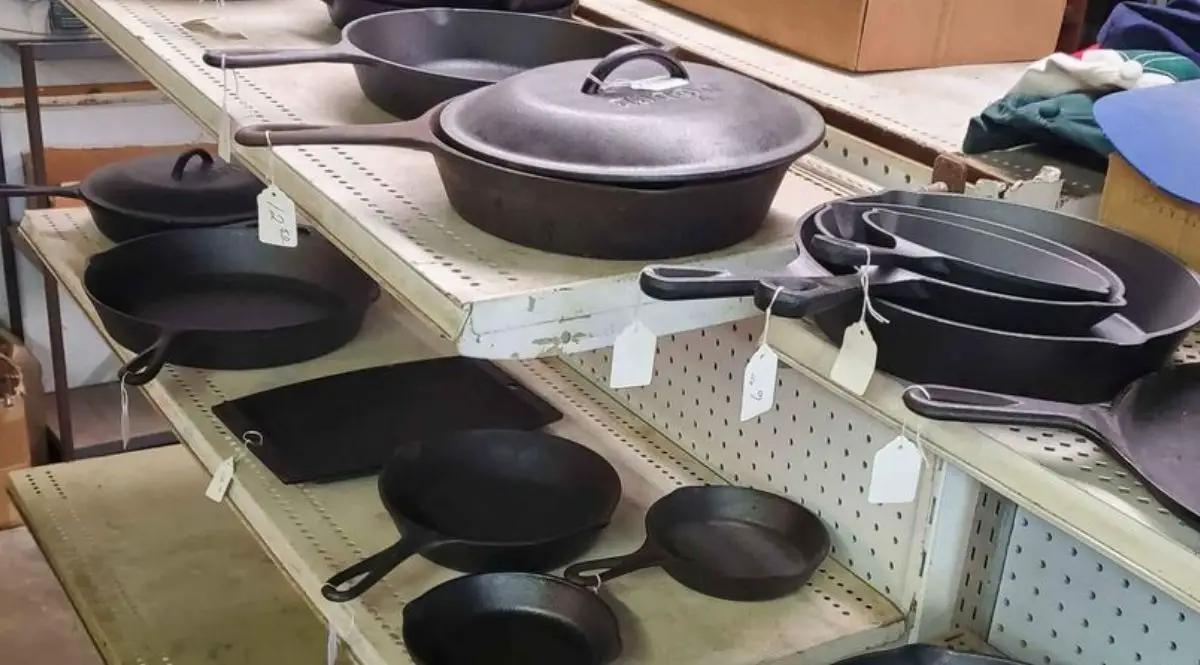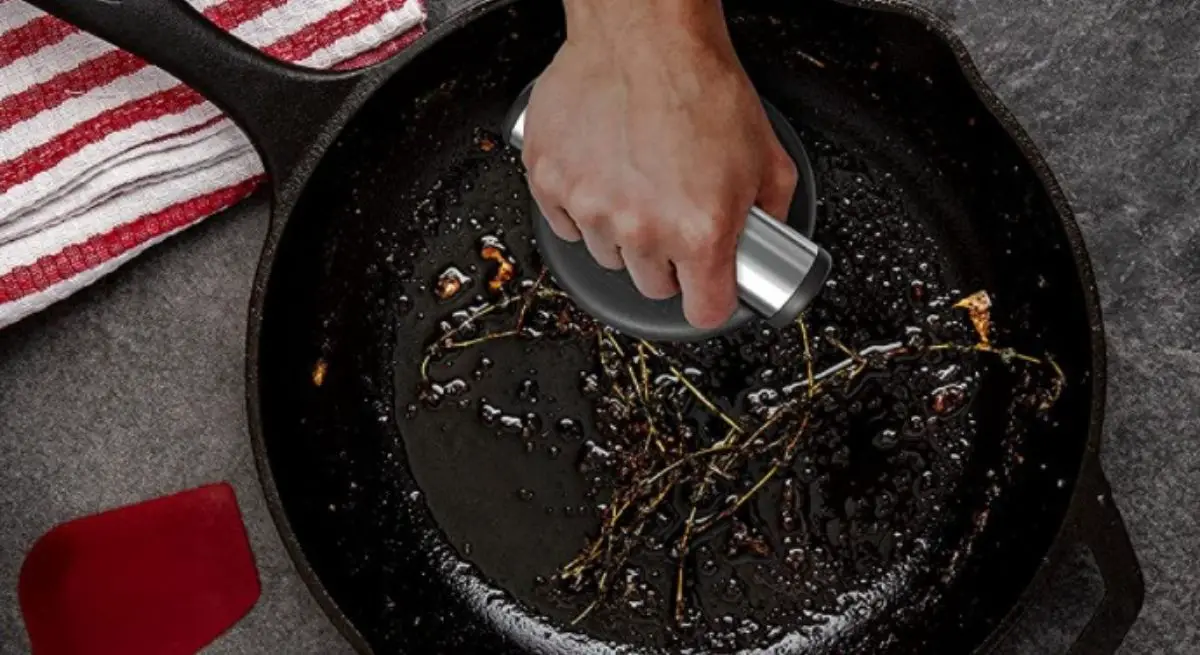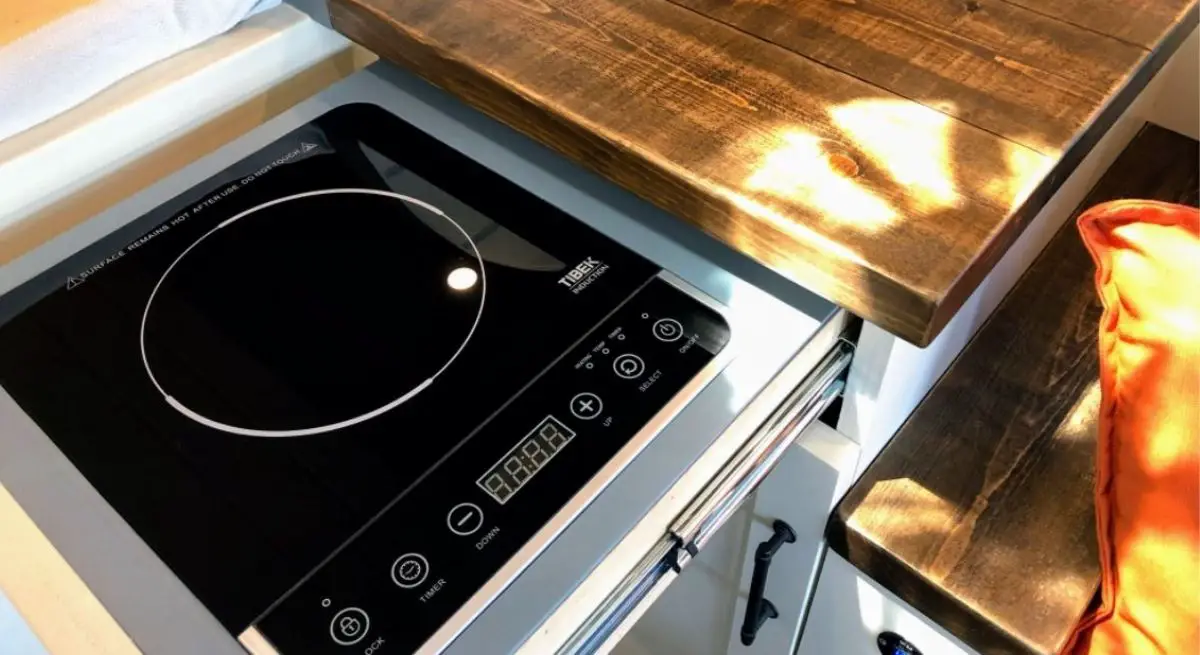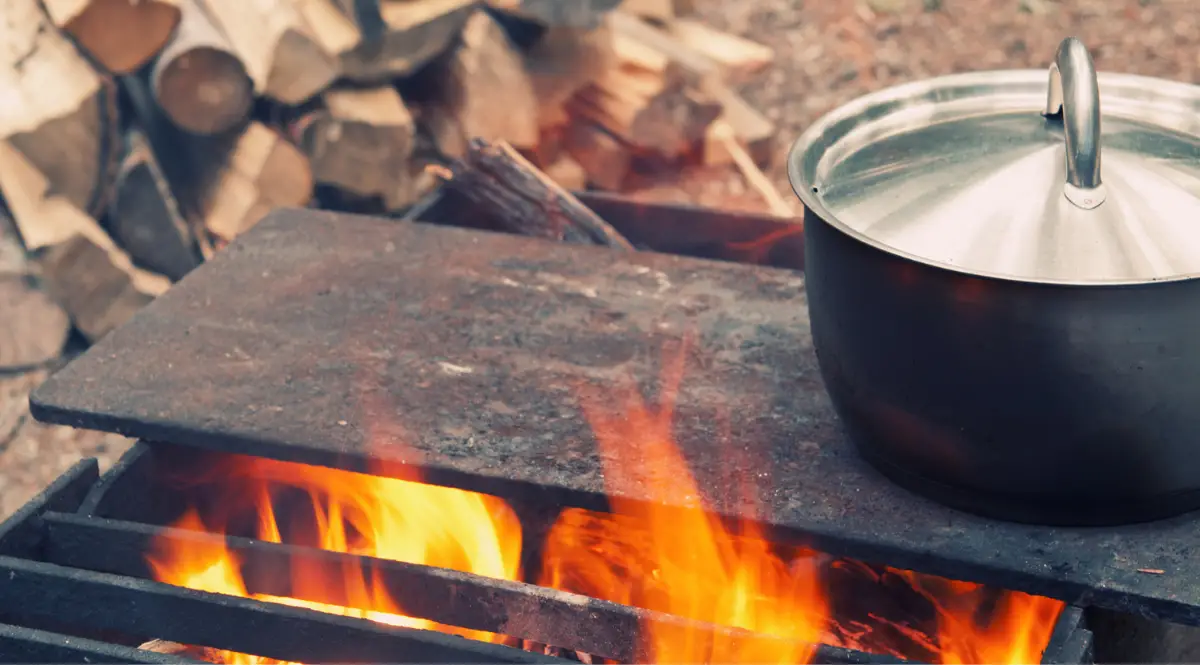Nothing screams Camping! like cooking over a campfire. Whether you’re cooking just for yourself or for a large group of family or friends, campfire cooking is the perfect way to prepare the ultimate camping meal. Of course, a campfire is far removed from the precise cooking appliances you may be used to using in your home.
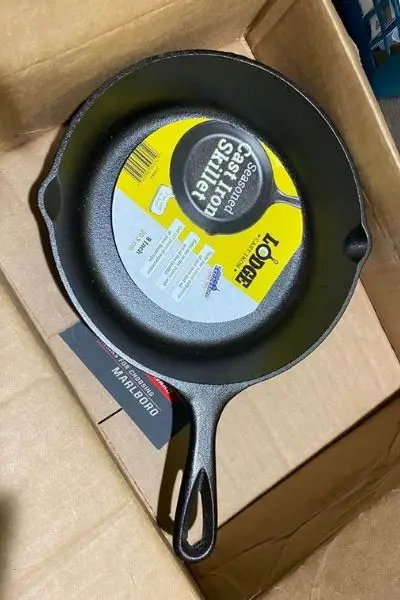
Even the appliances in your RV, or a backyard grill for that matter, provide a far more controlled cooking environment than you’ll get from a pit of wood surrounded by stones or an old truck rim. Fortunately, with the right tools, techniques, and some practice you can make just about anything over a campfire.
Perfect burgers, steaks, corn on the cob, fish, shrimp, chicken, ribs, brisket, chili, soups, and even bread, cakes, pies, and pizza are all within reach. Let’s take a look at what we’ll need to accomplish this seemingly impossible feat of culinary heroism.
What Do You Need For An Open Fire Cooking With A Griddle/Skillet?
To cook over an open fire you will need a way to control the temperature, quality cast iron or stainless steel cookware, long-handled BBQ utensils, good heat resistant BBQ mitts or gloves, and a digital food thermometer. These are all relatively inexpensive and easy to store in your RV.
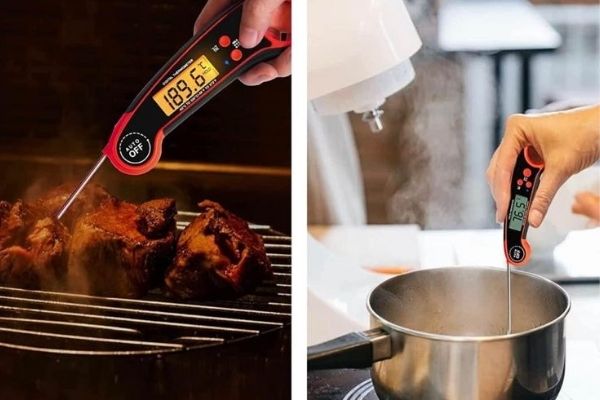
- What is your setup? (Open Firepit with a swivel arm or fire pit with a grill or portable fire pit)
Depending on where you are camping you may have several options for campfire cooking. Most private campgrounds will provide a fire ring and have firewood available. These fire pits can range from an old tractor rim or stone ring to fancy decorative metal rings with integrated adjustable grill racks.
Some campgrounds don’t provide a fire ring but will allow you to have a fire if you bring your own. There are three good choices for portable fire pits you can take with you. First is a basic wood fire pit. These are cheap, lightweight, easy to bring with you, and easy to set up. Before buying one, figure out how you want to transport it and choose one that will fit in the space you want to use. Next are the new smokeless wood fire pits. These can be very small and easy to transport and they produce good fires with little to no smoke. They can be pricey and many require pellet fuel so make sure you have what you need to run yours before setting out. Finally, there are several gas (propane) fire pits available on the market. These are great for campsites where wood fires are not allowed. They can be cumbersome to travel with so be sure to look for one designed for travel.
- Cast Iron Vs Stainless Steel Cookware
Do you need cast iron cookware to cook over a campfire? Not necessarily. Quality stainless steel cookware like that made by All-clad makes an excellent substitute. If you’re a purist, cast iron is the only way to go. People have been cooking on cast iron cookware over wood fires for a very long time. Cast iron has better heat retention and distribution properties than stainless steel, but that comes with a significant weight penalty. Heavy things and RVs generally don’t mix and if weight is a concern in your RV then stainless steel cookware is an excellent, lighter weight substitute to cast iron.
If your cooking plans call for a dutch oven then stick with the cast-iron variety and look for one with a recessed (concave) lid or lid rim. That lid style serves an important purpose when cooking over a wood fire. It allows you to set the Dutch oven in the coals and shovel coals on top of the lid so the food heats from all directions.
- Choosing the best Leather gloves for campfire cooking
Protecting your hands from burns while cooking over an open fire is critical, especially when camping in remote locations where proper medical attention could be far away. Traditional leather welding/fire-resistant gloves can provide excellent protection up to around 930 degrees F which should offer more than adequate protection around most campfires. While they do offer excellent protection from heat, they can be cumbersome to work in when handling kitchen tools like tongs or spatulas. Silicone-based BBQ grill-specific gloves offer higher temperature protection at over 1400 degrees F and tend to offer better finger dexterity when working with cooking utensils.
- Cast iron griddle
Cast iron griddles are a great way to cook all sorts of foods. They are available in rectangular and circular shapes – the round ones being a great fit on a campfire tripod grate. They are also available in smooth or ribbed surfaces. The smooth ones are great for sauteing veggies or cooking breakfast items like eggs, pancakes, sausage, or bacon. The ridged ones work great for cooking steaks and other meats where you want those fancy grill marks.
- Extra Long tongs, turner, basting brush
Extra-long tools designed specifically for campfire cooking will make your cooking experience much more enjoyable. A basic set should include a set of tongs, a fork, a basting brush, and a spatula. The longer the length, the more likely you’ll be able to work with your food without the need to wear cumbersome heavy gloves. This will allow you to work faster without less risk of accidentally dropping food into the fire.
- High heat oil – butter, lard, duck fat, etc.
There is a long list of oils available for cooking over a campfire. One of the key properties you will want to look for is an oil with a high smoke point. Depending on what you are cooking it may also be important to choose one with a neutral flavor. Those without a neutral flavor will affect the final flavor of the food which may or may not be a good thing.
- Your plates & cutlery
When your food is done cooking you’ll need plates and cutlery for serving it. Paper plates and plastic cutlery work well in camping situations. The paper can be burned in the fire and the plastics are easily thrown away. It’s generally best to avoid foam disposable plates because they take up a lot of space in the trash.
If you want to go more upscale, Correl dinnerware brings nice plates to the table. These are exceptionally popular with RVers because they look great, are nearly indestructible, are microwave safe, and weigh almost nothing. If you don’t mind washing dishes or prefer not to fill up the local landfill, these are the best way to go.
- The food you want to cook
With the proper tools, patience, and a little bit of experience,, you can cook just about anything over a campfire. One of the great joys of RVing is sampling the local fare. If you can, head out to a local farmer’s market or local shops that specialize in locally sourced foods. There’s nothing like a campfire clam bake or fresh lobsters boiling in a pot while on a trip to Maine. Of course, any family favorite is usually better when cooked over a campfire so don’t hesitate to give whatever meal you love a try.
Cooking Steps
For best results, I generally follow this procedure.
- Prep food in advance so it’s ready to cook when the fire is hot.
- Start the fire and get a good base of coals going
- Find the height that I want to set the tripod grate by finding the height above the fire where I can hold a bare hand for only a couple of seconds.
- Set up the tripod and set the grate to that height
- If I need any other cookware, place it on the cooking grate and add any cooking oils
- Let it heat until ready, spinning the grate slowly over the fire for even heat
- Add food to cook
- Spin the grate slowly for even cooking
- Control temperature by adding wood to the fire and/or raising or lowering the grate as needed.
- Check food temperature with a digital thermometer for doneness
- When done, remove food and enjoy.
Get The Coals Ready For Your Cooking
When cooking with a tripod you really don’t need to get the coals ready. You can cook right over actively burning wood. If you are cooking with a Dutch oven or lining the fire with food then allow your fire to burn down into a nice pile of hot coals.
Those coals can then be spread out to provide heat where you need it. If for example, you are going to be cooking in a Dutch oven then you can lay some coals down, place the oven on top, shovel some more coals around the oven and even put some on the lid.
Moving some hot coals near the rim of the fire and laying corn on the cob still in the husks near the coals is a great way to cook corn. Soaking the corn in the husks for an hour or two in cold water can help steam the corn inside while preventing the husks from charring too quickly.
Pre-Heating Your Cast Iron For Even Cooking
Cast Iron is an excellent conductor of heat that cooks best when it is properly preheated to cooking temperature before the food is added. If the pan is large enough to sit over hot and cool zones of the fire, make sure you rotate the pan frequently until it is uniformly hot. You can also push the coals of the fire around under the pan to get a more even fire under it.
How Can You Tell Your Cast Iron Is Hot Enough?
There are a couple of reliable ways to tell if your pan is hot enough. Many recipes suggest looking for light smoke coming from the oil in the pan. This indicates that the oil has reached its smoke point and should not be heated any higher.
Another option is to dip your fingers in some water and fling a few drops into the pan. Never spray water into a hot pan of oil. When the water drops hit the pan or oil they should instantly boil vigorously. If they don’t, continue to let the pan heat.
One final method would be to use a laser thermometer. This would give an actual surface temperature and would be a great option if you are trying to cook at a specific temperature in something like a Dutch oven. This may be overkill, but they are accurate, inexpensive, and can be useful for other things around the RV.
Be Generous With The Oil To Enhance The Non-Sticking
Cast Iron, or stainless steel if you go that route, is not considered “non-stick” on its own. Properly seasoned cast iron and properly cleaned stainless steel will act fairly non-stick when they are properly oiled and preheated before the food is added.
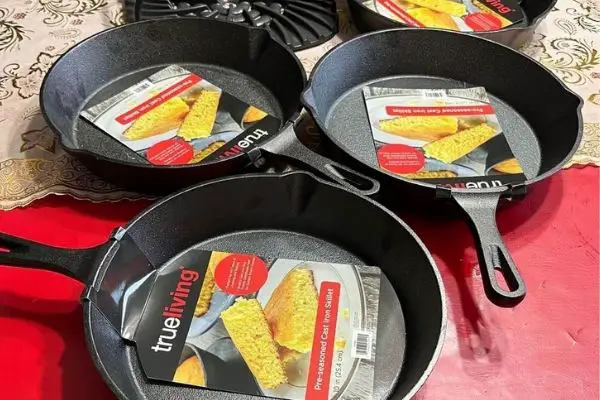
While it’s common practice these days to forgo light on the oil for dietary reasons, adding a little extra when using these pans will go a long way in preventing your food from sticking. You don’t have to go crazy, just make sure there is a good consistent coating across the entire cooking surface.
Heat Control Is The Secret To Cooking
The key to great cooking regardless of the heat source is temperature control. Too cold and you’ll be staring at that slab of steak until you fall asleep. Too hot and you’ll quickly burn whatever dinner was into an inedible pile of dried carbon. Neither of which will bring you the coveted “Master of the campfire” award.
Controlling the temperature of a campfire can be an impossible task. Yes, wood does burn at a specific temperature. However, the rate of burning and the overall amount of heat generated can vary greatly depending on the type of wood, how wet it is, and how well your campfire setup can supply the burning embers with the oxygen it needs to keep going.
Even atmospheric conditions like outside temperature and humidity can affect your campfire’s overall temperature. All of these things can vary greatly in a camping scenario where you don’t have any control over the source of the wood, the weather, or the firepit construction. To overcome those unknowns, we resort to controlling the temperature in one of two ways.
The most common way is to have some way of easily controlling the distance between food and fire. Option two is to maintain a fire, remove coals from the fire and use those for direct contact cooking. Once burned down, the coals will be at a fairly constant temperature and you can adjust the heat by adjusting the number of coals you are using. Personally, I much prefer the distance method since it is easy to test and can be adjusted quickly as the fire changes.
To use the distance method you’ll need some sort of grate that is easily height adjustable that can go over the fire. Some campgrounds will have firepits that have a swivel out or fixed position height adjustable grate attached to the fire pit. These will do in a pinch, but they usually don’t have more than a few inches of height adjustment. Given that, you’ll need to be very careful in maintaining a consistent fire.
The far better option is something like the Coleman Campfire Tripod. For campfire cooking I consider these to be the ideal tool for temperature control. The cooking grate is supported by a chain which is easily adjusted up or down as your fire conditions change.
This movement is in feet and is more than enough to accommodate large fluctuations in fire size. Also, the cooking grate can spin on the chain. A campfire isn’t consistent heat in all areas. By slowly spinning (don’t spin it so fast your food flies off) the grate on the chain, the food or cooking surface will rotate over the hot and cool areas of the fire to heat more evenly.
To make things even better, these weigh only 2 lbs and fold up for easy storage in your RV. For these reasons, the campfire tripod easily makes my list of the top 5 RV cooking must-haves for all RVers.
When setting up my tripod, I’ll run my bare hand over the fire starting very high and I’ll continue to make lower and lower passes until it’s hot enough that I can only hold my hand comfortably at that height for a couple of seconds. That’s the height I then set my tripod grate to.
I let that heat up and then add the food. This is the case for any food I place near the fire. If you have it closer to the fire then your bare hand can stand for a couple of seconds then it’s likely it will burn instead of cook.
Cleaning Your Cast Iron
Cast iron is easy to clean after cooking. Don’t use any abrasive cleaners (Bar Keeper’s Friend, Baking Soda, etc.), abrasive pads, or soap as those will remove the seasoning layer of burned-on oil that protects your cast iron from corrosion.
Instead, while it’s still warm squirt in some hot water and wipe it out with a soft sponge. You may need to do this a couple of times to get it clean. Once you have it clean, wipe it completely dry with a paper towel and apply a light coating of vegetable oil. With another dry paper towel wipe out the excess oil and return the pan to storage.
Common Questions:
Can You Get A Cast-iron Skillet Too Hot over a campfire?
A wood fire will not get hot enough to damage a cast iron pan. You can get the pan too hot to cook many foods in. An over-heated pan will cause any added cooking oil in the pan to smoke, a little smoke from the oil is often ok and many recipes suggest adding food to the pan when you start to see the oil in the pan smoke a little. Heavy smoke indicates a pan that is too hot. In this case, the oil will likely burn and transfer an off taste to any food you cook in it.
What Happens When You Add Your Food To A Cast Iron When It Is Not Hot
If the pan is not hot when you add the food you increase the chances it will stick and food will not begin to cook until the pan reaches the appropriate temperature. This can make it difficult to achieve proper doneness because the rate of cooking will change as the pan heats up. You should always check your pan temperature before adding your food for the best results.
What Happens If You Don’t Add Oil To Your Cast Iron Skillet When Cooking
If you don’t add any oil to the skillet when cooking then your food will likely stick to the pan. If you’re cooking something with high-fat content, that fat can render out of the food and provide the oil your need, but until that happens expect the food to stick to the pan.

